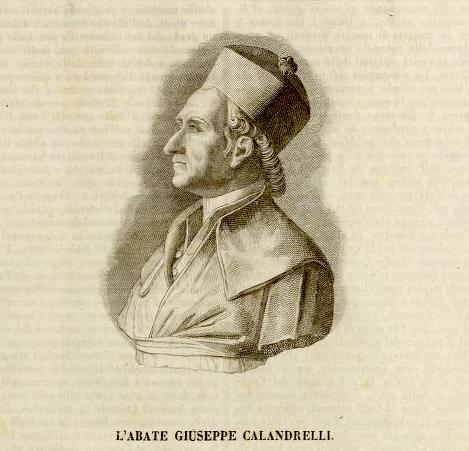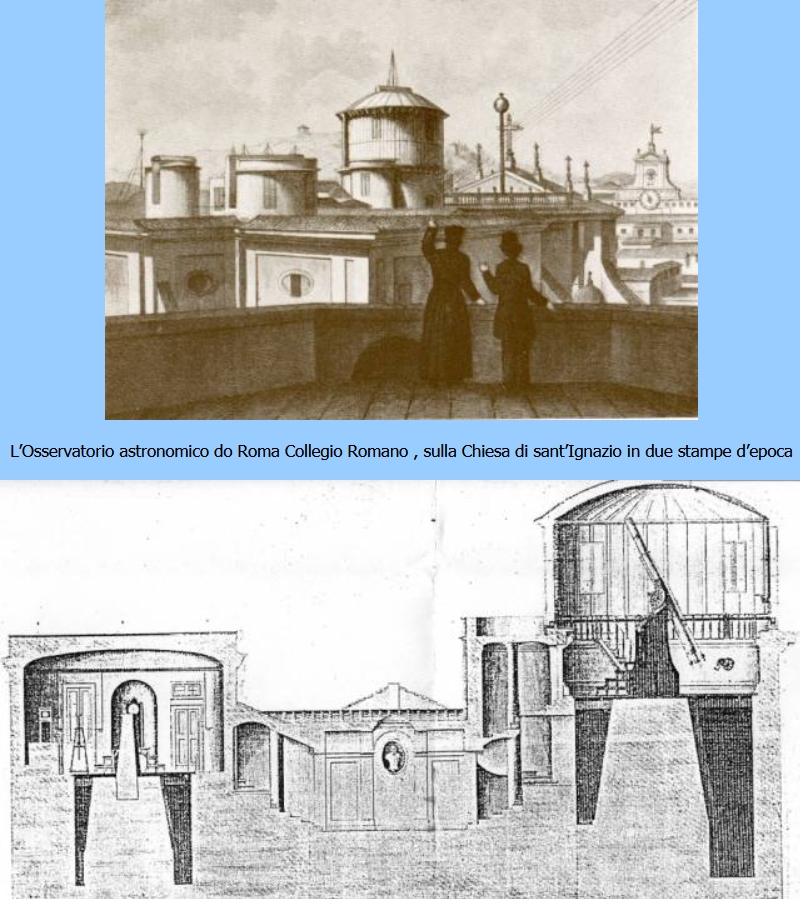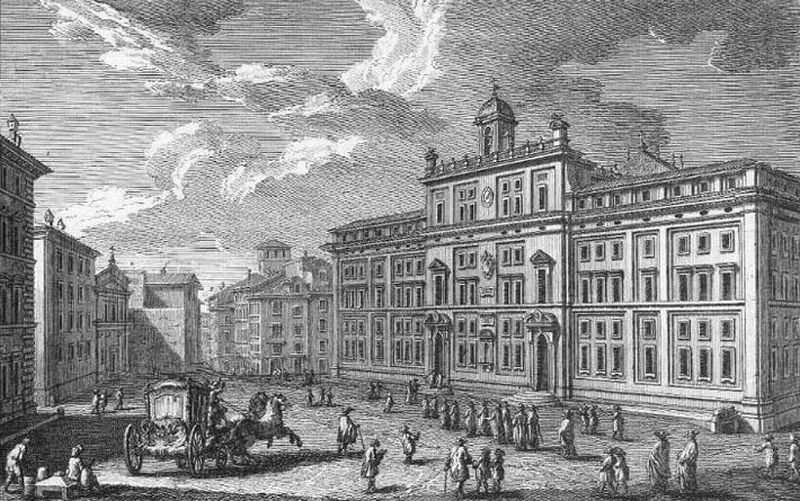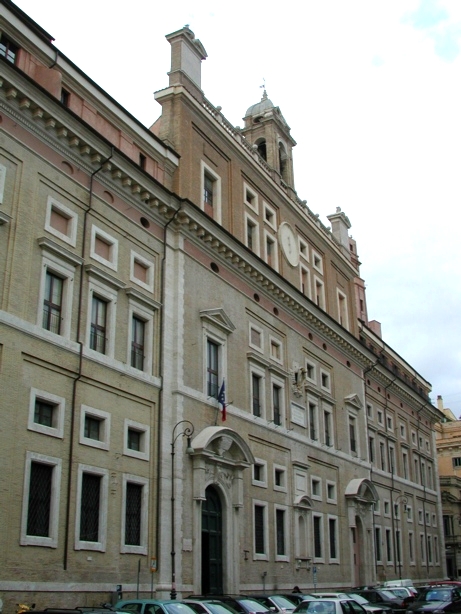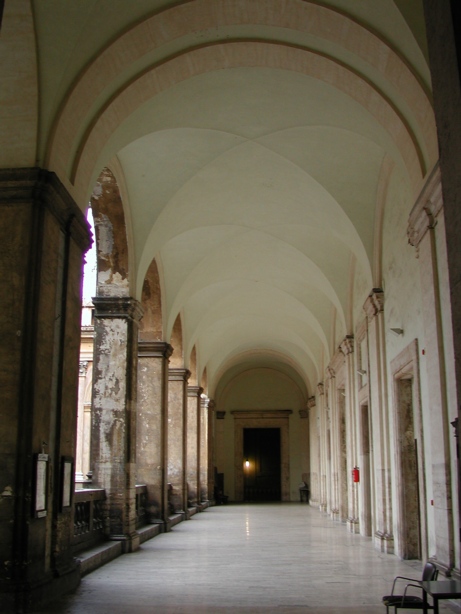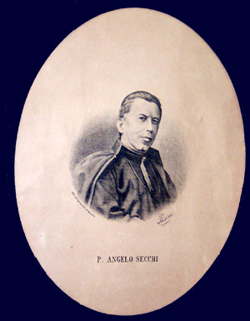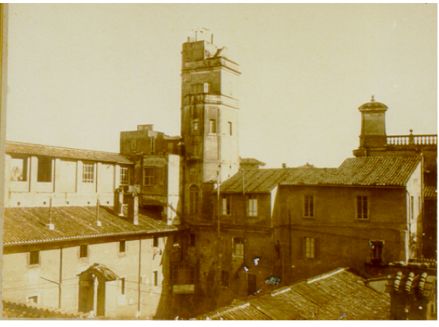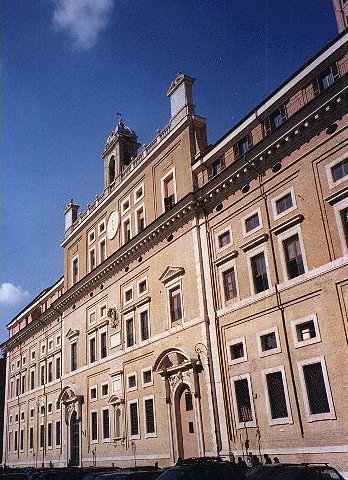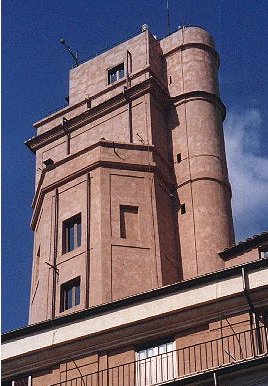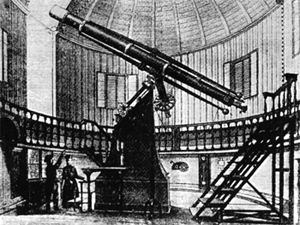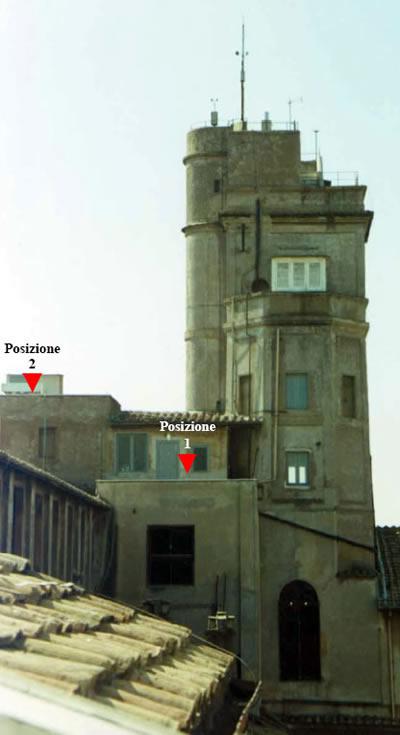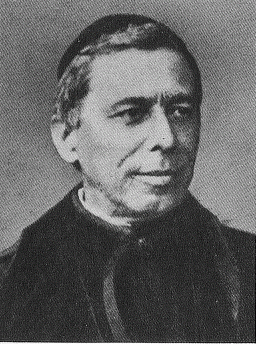
Category of Astronomical Heritage: tangible immovable
Osservatorio del Collegio Romano, Cathedral of St. Ignatius of Loyola, Rome, Italy

Description
Geographical position
Osservatorio del Collegio Romano (Observatory of the Roman College), Cathedral of St. Ignatius of Loyola in Campo Marzio, Piazza del Collegio Romano, 1A, 00186 Roma RM, Italy
Location
Latitude 41°53'55.2" N, Longitude 12°28'49.5" E, Elevation ....m above mean sea level.
IAU observatory code
531
Description of (scientific/cultural/natural) heritage

Fig. 1. Museo Kircheriano (1651)
The Collegio Romano was founded in 1551. The Palazzo was built in 1582/84 by Bartolomeo Ammannati for the Collegio Romano, a Jesuit (Roman Catholic) College. Under the patronage of Pope Gregory XIII, the final seat of the Roman College was built in 1584 with the church St. Ignatius of Loyola (1626).
The German Jesuit scholar Athanasius Kircher (1602--1680), "Master of a Hundred Arts", was a professor at the college and left on the premises a museum (Museo Kircheriano (1651) -- "Wunderkammer") filled with his works.
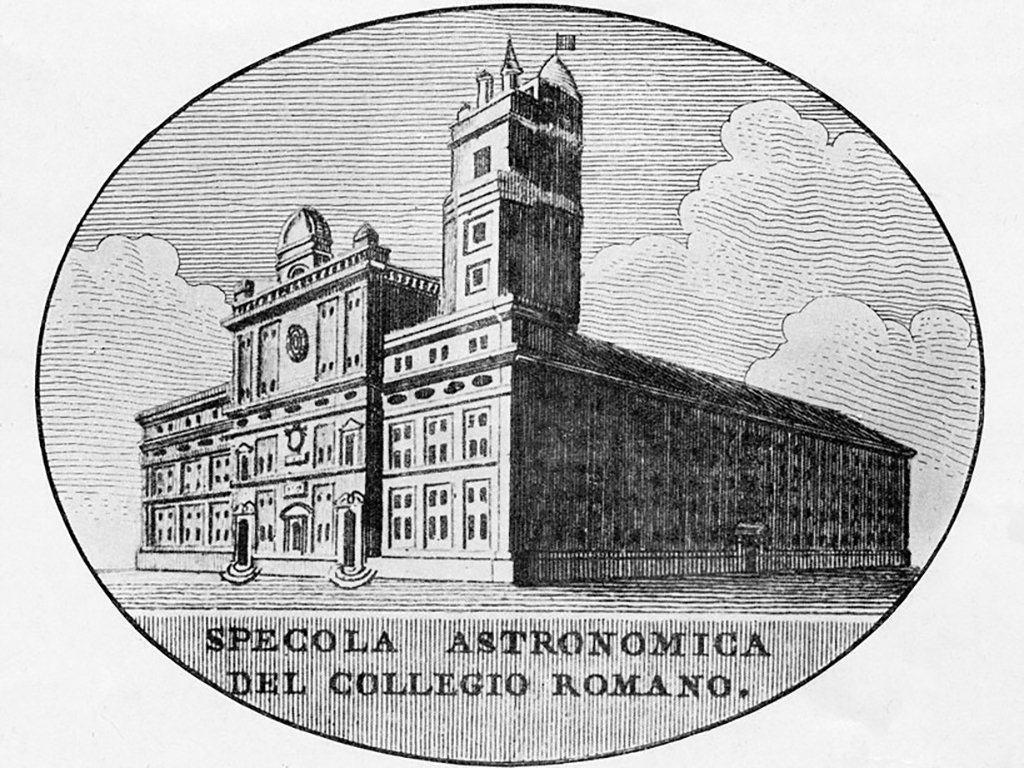
Fig. 2. Calandrelli Tower of the Roman-College ....
Calandrelli Tower -- Specula Astronomica of the Collegio Romano (1787)
After the suppression of the "Society of Jesus" in 1773, the Pope ordered the establishment of the Pontifical Observatory there in 1774. This was the beginning of the famous Specula Astronomica of the Collegio Romano, in 1787, a 67-m-high tower was constructed by Cardinal Francesco Saverio de Zelada (1717--1801) on the roof of the annexed St. Ignatius of Loyola church.
The first astronomers were Guiseppe (1749--1827) and Andrea Conti (1777--1840), later in 1816, Giacomo Ricchebach (1776--1841). They published 8 volumes "Opuscoli Astronomici" (1803--1824). But the tall tower was not suitable, not stable enough for the 19th century telescopes and precision measurements.
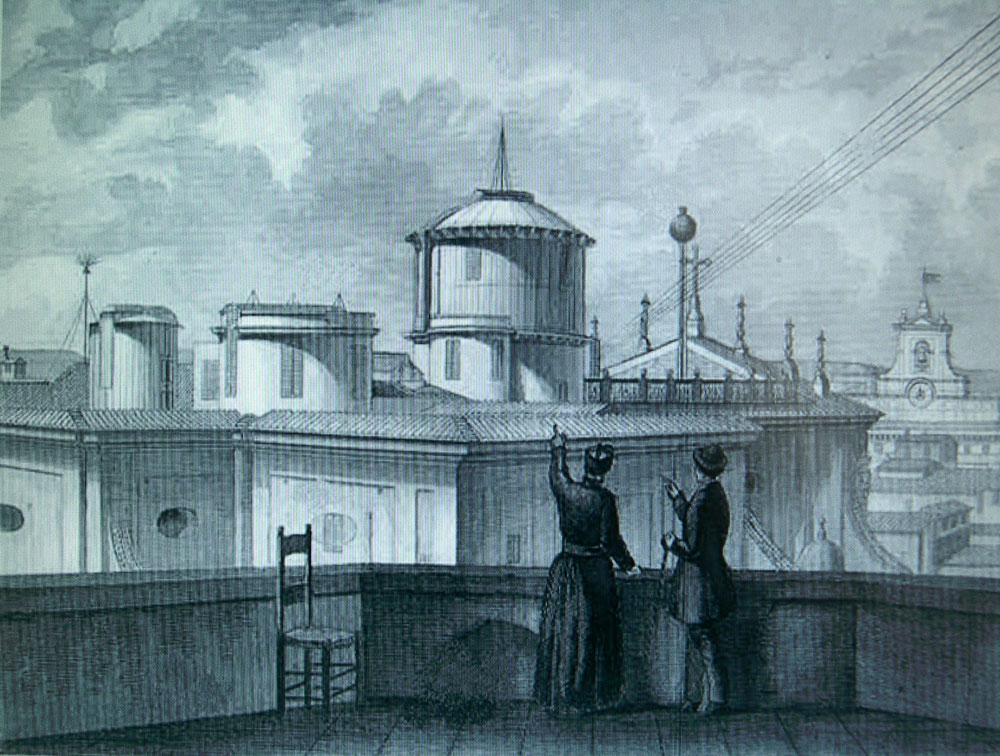
Fig. 3. Observatory of the Roman College (1787)
1 - Main Observatory of Equatorial Merz telescope.
2 - Main staircase to the Observatory.
3 - Observatory for the Ertel meridian circle.
4 - Observatory for the telescope of Cauchoix.
5 - Observatory electric tower with small lead ball.
6 - Antenna with globe dropped at midday as signal to fire the cannon at Castel Sant'Angelo (now on the Janiculum).
7 - Electric cables transmit signals from meteorological sensors on Calandrelli Tower to meteorograf recorder housed in room below main observatory.
8 - Rear of St. Ignatius facade.
9 - Back of Church of St. Ignatius.
11 - Tower Terrace.
12 - Roof of Palazzo Montecitorio, now the Chamber of Deputies.
The Jesuits Return
In the year 1824, the Roman College -- later also called the "Gregorian University" -- and the annexed Church of St. Ignatius were returned to the re-established Society of Jesus.
Leo XII, with the Apostolic Letter Quod divina sapientia, gave in that year an order to the study of sciences in the universities of the Papal States. Rules were also given for the directors of the observatories: they must observe the sky without rest, compile and publish bulletins. They must also correspond with the most famous astronomers, in order to be informed of the new discoveries that must be examined and exploited for the benefit of the students, for the good not only of the sciences, but also of the supernatural ones.
In returning the College to the Jesuits, the Pope wanted the well-deserving Calandrelli to remain in charge of the observatory. However, he preferred to retire together with his colleagues and took his instruments to the Collegio S. Apollinare, the new seat of the Roman Seminary, but his sudden death, in 1827, put an end to his scientific plans.
Father Dominique Dumouchel (1773--1839) was nominated as new director of the Roman College 1824 to 1838. He was educated at the Polytechnic in Paris. He lamented the condition of the observatory and the instruments, and stressed the need for a new construction and the purchase of the indispensable instruments. In 1825, Father Fortis, General of the Society of Jesus, donated to the observatory an azimuthally mounted Cauchoix telescope. In 1842, Father General Roothaan procured a meridian circle of Ertel. But the unstable tower remained in use until 1850. Dumouchel is well known for his discovery of Halley's comet on its return in 1835 with the Cauchoix refractor -- on the basis of the calculations of his assistant Father Francesco De Vico (1805--1848).
De Vico became the next director from 1839 to 1848. He observed Saturn's satellites, Mimas and Enceladus. Other famous discoveries were eight comets in 1844-1847 -- rewarded by the King of Denmark; one of the comets, with a period of about 67.5 years, was given the name of Father De Vico. He had the interesting idea of making a catalogue of the northern sky with stars up to the eleventh magnitude in order to make the discovery of comets and new asteroids easier. The revolution of 1848 caused that Jesuits were dispersed throughout the world. De Vico was nominated as director of the Georgetown College Observatory, but he died already in 1848.
After the interruption due to the time of the Roman Republic 1848 to 1849, the Jesuits reopened the observatory of the Roman College.
The highlight -- the time of Father Angelo Secchi (1850--1878)
In 1850, Father Angelo Secchi (1850--1878), the young physicist, became director. His new Merz refractor was placed he sturdy walls of the church of St. Ignatius in a dome with a diameter of 17m. The engineer A. Vescovali built two small circular and elliptical rooms for the instruments, a meteorological station, and rooms for the observatory with library. In 1853, the new "PontifIcal" observatory was inaugurated by Pius IX. It also provided the official time for the Vatican, indicated by dropping a time ball at noon at the top of Saint Ignatius Church. In addition, magnetic observations were started in 1858 with a inclinometer and a declinometer.
The Observatory of the Roman College was famous for replacing the old "Italian" hours (24 hours, starting at half an hour after sunset), where the noon was indicated with a cannon shot from the Fort of Castel Sant'Angelo) with the signal given by the fall of the time ball along a pole hoisted on the roof of the church of Sant'Ignazio like in other European cities.
Secchi had a broad interest in different fields: He observed not only double stars, nebulae, planets and comets (1852--1853), but he studied terrestrial magnetism, meteorology, and conducted trigonometric measurements with the base on the Via Appia. The highlight of his research was the introduction of astrophysics, he studied the Sun in detail using a spectroscope (he found the connection between the prominences and sunspots), then he extended his spectroscopic research to the fixed stars with an objective lens prism in front of the Cauchoix refractor. This led him to a classification of four classes (later in the Harvard classification the stars are divided into seven spectral classes O, B, A, F, G, K and M). Secchi published about 730 small treatises.
The Roman College of the Society of Jesus was closed during the revolutionary capture of Rome in 1870, and declared property of the Italian State.
In 1873, the Gregorian University "Pontifical Gregorian University of the Roman College", fostered by Pope Leo XIII, was founded, including the remaining philosophical and theological faculties of the former Roman College. The astronomical observatory, scientific laboratory, the libraries, and the Kircher Museum were taken over by the new government in 1873. The Library of the Roman College merged in 1873 into the Biblioteca Nazionale Vittorio Emanuele III.
After Secchi's death, the observatory of the Roman College was annexed in 1878 to the Royal Central Office of Meteorology.
Gaspare Stanislao Ferrari (1834--1903) became Professor of Astronomy at the Gregorian University, and director of the observatory, retired in 1894. In his private observatory, Villa Cecchina, he used a 9'' Merz refractor.
History
Instruments
- Pendulum clock
- Achromatic telescope, made in Paris
- Transit telescope, made by Reichenbach of Munich
- Refractor, made by Cauchoix of Paris (1825), azimuthally mounted
- Meridian circle, made by Ertel of Munich (1842)
- 24-cm-Equatorial telescope (focal length 435cm), made by Merz of Munich (1854)
- Magnetic instruments: declinometer and inclinometer (1858), installed in a room without magnetic materials.
- Direct vision Spectroscope, made by Jean George Hoffmann of Paris (1862), used with the Merz Equatorial (cf. Colombo 2018)
Present use
Today the eastern wing of Collegio Romano is used by the headquarters of the Ministry of Heritage and Culture, and another wing is used by the high school "Ennio Quirino Visconti" Liceo Ginnasio.
Astronomical relevance today
The Osservatorio del Collegio Romano is no longer used for astronomy.
References
Bibliography (books and published articles)
- Baldini, Ugo: Calandrelli, Giuseppe. In: Dizionario Biografico degli Italiani, Vol. 16. Rome: Istituto della Enciclopedia Italiana fondata da Giovanni Treccani 1973.
- Chinnici, Ileana & Guy Consolmagno (eds.): Angelo Secchi and Nineteenth Century Science. The Multidisciplinary Contributions of a Pioneer and Innovator. Cham: Springer International Publishing 2021.
- Chinnici, Ileana (ed.): Merz Telescopes. A global heritage worth preserving. Springer International Publishing 2017.
- Colombo, Lino: The spectroscope de poche source of Angelo Secchi's stellar spectroscopy research. In: Atti del XXXVIII Convegno annuale SISFA - Messina 2018, p. 189-194.
- Lattis, James M.: Calandrelli, Giuseppe. In: Hockey, Thomas; Trimble, Virginia; Williams, Thomas R.; Bracher, Katherine; Jarrell, Richard A.; Marché, Jordan D.; Ragep, F. Jamil; Palmeri, JoAnn & Marvin Bolt (eds.): The Biographical Encyclopedia of Astronomers. New York, NY: Springer 2007, p. 191-192.
- Monaco, G.: Giuseppe Calandrelli and his first applications of gravitational theory to the cometary atmospheres. In: Memorie della Societa Astronomica Italiana 60 (1989), p. 783-789.
- Udías, Agustín: Searching the Heavens and the Earth: The History of Jesuit Observatories. Dordrecht: Kluwer Academic (Springer Science & Business Media) 2013.
- Udías, Agustín: Jesuit Contribution to Science: A Historiographical Essay. Dordrecht: Brill 2014.
- Udías, Agustín: Jesuit contribution to science, 1814--2000. A Historiographical Essay. In: Journal of Jesuit Studies 1 (2014), no 1, p. 88-104.
- Udías, Agustin: Jesuits and the Natural Sciences in Modern Times, 1814--2014. In: Jesuits and the Natural Sciences in Modern Times, 1814--2014. Leiden: Brill (Brill's Research Perspectives in Jesuit Studies) 2019, p. 1--104 (doi.org/10.1163/9789004394902_002).
Links to external sites
No multimedia content published
Currently there is no multimedia content published for this case study






